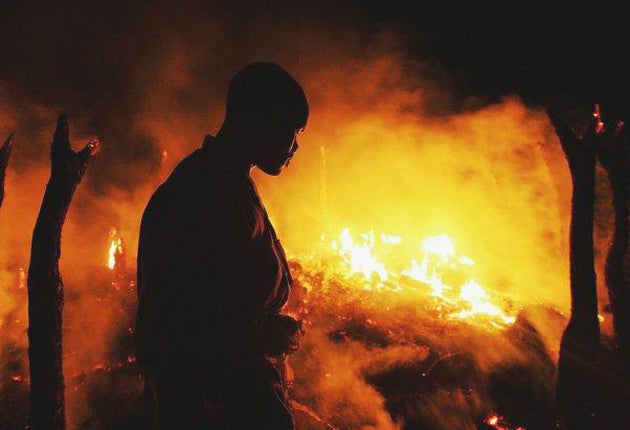Chilling climate warning from history as drought drove starving Huns to invade Rome
UN warns of mass migration and conflict as climate crisis stifles access to resources

Climate-led drought may have triggered the Hun invasion of ancient Rome, a new study suggests – which could have chilling implications for humanity today.
Archaeologists suggest dry summers in the 5th century may have encouraged animal herders to become raiders, with devastating consequences for the Roman empire.
The study, published today in the Journal of Roman Archaeology, argues that similar extreme drought spells from the 430s – 450s CE disrupted ways of life in the Danube frontier provinces of the eastern Roman empire, forcing Hunnic peoples to adopt new strategies to ‘buffer against severe economic challenges’.
The research comes at a time when more people than ever are being forced to flee their homes because of the climate crisis.
According to the United Nations High Commissioner for Refugees (UNHCR), an annual average of 21.5 million people have been forcibly displaced by weather-related events – such as floods, storms, wildfires and extreme temperatures – since 2008. These numbers are expected to surge in coming decades with forecasts from international think tank the IEP predicting that 1.2 billion people could be displaced globally by 2050 due to climate change and natural disasters.

The threat of war over climate-led dwindling resources, such as water, is also growing.
Violence in Darfur in Sudan has been described as the world’s first climate change war in a UN report, where a combination of political instability and lack of water have caused diminishing resources and conflict between two communities who have lived side-by-side for centuries.
The authors of the Hun study, Associate Professor Susanne Hakenbeck from Cambridge’s Department of Archaeology and Professor Ulf Büntgen from the University’s Department of Geography, came to their conclusions after assessing a new tree ring-based hydroclimate reconstruction, as well as archaeological and historical evidence.
Prof. Hakenbeck warns against drawing direct parallels between the Hun invasion and current conflicts and migration sparked by the climate crisis. However, she said: “I think what our research has showed is that climate stress, specifically drought, causes people to make changes to how they live.
“They might migrate to an area where they have resources or they may also turn to violence.”
The study argues that some Hunnic peoples dramatically changed their social and political organisation to become violent raiders.
Hakenbeck added: “Climate alters what environments can provide and this can lead people to make decisions that affect their economy, and their social and political organisation. Such decisions are not straightforwardly rational, nor are their consequences necessarily successful in the long term.”
“This example from history shows that people respond to climate stress in complex and unpredictable ways, and that short-term solutions can have negative consequences in the long term.”
Andrew Heath is the international media manager for the UK charity Practical Action, which works on the front line of climate change in Darfur. He says the historical situation is mirrored today in Sudan.
The sedentary farming population and the migratory pastoral community are often competing over access to water, but they have also seen drought and the removal of trees cause desertification and the reduction in pastureland for cattle.
Conflict is exacerbated by access to arms and it has led to explosions in conflict, which have led to hundreds of thousands of deaths in recent decades.
He said: “When people first get together they can often be extremely angry. The work Practical Action does is implemented by people from Darfur. They give both sides time and space to talk and tensions eventually reduce and people realise coexisting is good for them.
“Our work attempts to manage water more effectively, so huge dams can capture rainfall, increase fertility and replant trees. We also work with both sides to mediate between them and ensure they agree on routes cattle can use and areas in which farming is permitted. Everyone agrees the environment and climate change is a huge problem.”
The Hunnic incursions into eastern and central Europe in the 4th and 5th centuries CE have long been viewed as the initial crisis that triggered the so-called ‘Great Migrations’ of ‘Barbarian Tribes’, leading to the fall of the Roman empire.
New climate data reconstructed from tree rings by Prof Büntgen and colleagues provides information about yearly changes in climate over the last 2000 years. It shows that Hungary experienced episodes of unusually dry summers in the 4th and 5th centuries.
Hakenbeck and Büntgen point out that climatic fluctuations, in particular drought spells from 420 to 450 CE, would have reduced crop yields and pasture for animals beyond the floodplains of the Danube and Tisza.
Büntgen said: “Tree ring data gives us an amazing opportunity to link climatic conditions to human activity on a year-by-year basis. We found that periods of drought recorded in biochemical signals in tree-rings coincided with an intensification of raiding activity in the region.”
Join our commenting forum
Join thought-provoking conversations, follow other Independent readers and see their replies
0Comments